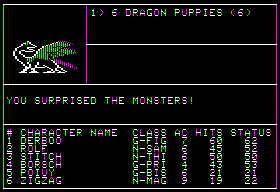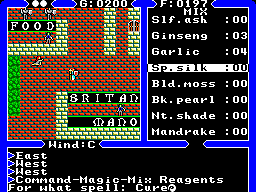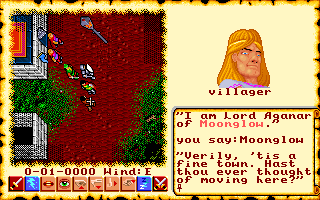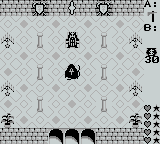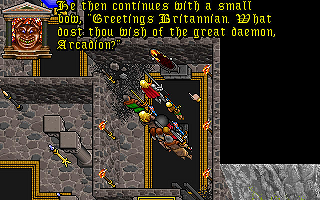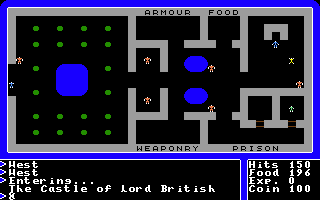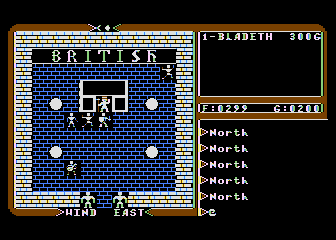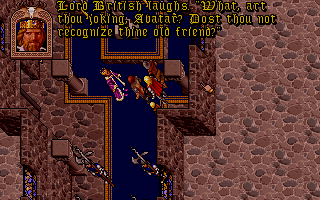- Ultima (Series Introduction)
- Akalabeth
- Ultima I: First Age Of Darkness
- Ultima II: Revenge of the Enchantress
- Ultima III: Exodus
- Ultima IV: Quest Of The Avatar
- Ultima V: Warriors of Destiny
- Ultima VII: The Black Gate
- Ultima VI: The False Prophet
- Ultima VII Part 2: Serpent Isle
- Ultima VIII: Pagan
- Ultima Underworld: The Stygian Abyss
- Ultima Underworld II: Labyrinth of Worlds
- Arx Fatalis
- Worlds of Ultima: The Savage Empire
- Ultima Worlds of Adventure 2: Martian Dreams
- Ultima IX: Ascension
- Lord of Ultima
- Ultima Online
- Ultima: Escape from Mt. Drash
- Ultima: Miscellaneous
- Richard Garriott (Interview)
Interview with Richard Garriott
Richard Garriott, aka Shamino Salle Dacil, aka Don Shamino, aka Lord British, original author of Ultima and one of the founding fathers of computer RPGs.
Let’s start at the beginning. Can you tell us about how you started programming back in high school? How was the Apple II better than connecting to a mainframe computer via teletype?
When I began in 1974, I was inspired by three things: The Lord of the Rings, Dungeons & Dragons and the unused teletype my school had in one classroom. I wrote 28 small BASIC D&D games before discovering the Apple II and its real time graphics! I immediatly wrote “D&D 28B” which became Akalabeth.
What were those first 28 games like? Since you didn’t have the Apple II’s graphics, would they be something like text adventures or dungeon-crawlers with ASCII graphics like dnd?
Ah… they looked a lot like Ultima! Just “*” for walls, ” ” (blank spaces) for hallways, “$” for treasure and “A” for Giant Ant as examples. It was a lot like a top down tile game, but made with ASCII characters. Also you had to wait 10-30 seconds for each new “frame”… very low “framerate”. 🙂
It’s hard to even imagine what programming was like in those days, having to wait while your data went to some hulking giant elsewhere on phone lines. What were you trying to do differently with Ultima I? And how did you and Ken Arnold distribute the workload?
“Hulking” is the right word… by today’s standards, unbelievably slow. Coupled with that 300 baud accoustic modem! Ken was my connection to assembly language. Ken wrote the first tile graphic copying routine in assembly for me. While his later work in Ultima music is still great, it was that one subroutine that put Ultima on track!
My significant other keeps getting Quest of the Avatar’s combat music stuck in her head thanks to the Ultima playing I’ve been doing these past few months, so I can attest he did some work. 🙂 I’m curious about that Space Ace section in the first game. It seems to play a lot like Doug Neubauer’s Star Raiders that came out a year or two earlier for the Atari 800.
Yes, the music still plays in MY ears too! I do remember Star Raiders too, and no doubt it was a strong influence!
In the first half of the ’80s, you were competing neck and neck with Sir-Tech’s Wizardry for sales. What kind of relationship did you have with Andrew Greenberg and Robert Woodhead over at Sir-Tech? Did anything they did affect how you designed an Ultima?
I know them both well and we have always been friendly competitors. Our games were different enough, that I rarely looked to them for inspiration. Odd really, likely should have studied them more… but I was too caught up in my own path at the time.
You certainly diverged in design philosophy rapidly. Ultima changed scope while Wizardry seems to have been content to keep refining the formula.
I agree. I was caught up in the rapid expansion of my skills… Ultima I in BASIC, Ultima II in assembly, Ultima III in far better assembly… I knew I could get much more out of the little machine, with each fresh restart.
I’ve compared the speed of Ultima I and Ultima II on an Apple IIe machine myself. The difference is very noticeable. Back in 1982 your games were briefly distributed by Sierra On-Line, and then you had something of a falling-out with Ken Williams prior to the development of Exodus. Ken Williams’ side of the story is in Stephen Levy’s book ‘Hackers’, where it seems like he was wary of independent authors and trying to replace them with traditional hired programmers. What’s yours? What wasn’t working?
HA! Mine is FAR more basic. THEY QUIT PAYING THE ROYATIES I WAS DUE! My first publisher California Pacific quit paying me because the owner was a major drug user and squandered the money they owed me. Sierra also just up and stopped paying, as they had financial troubles as well. In both cases I brought in my brother Robert to try and collect… never could… so we went into business ourselves, and started Origin!
“Not being paid” sounds like the most basic reason to quit a job, sure enough! Speaking of Origin… The video game and computer industry crash in 1983-1984 has been much mythologized. You were there at the time starting up Origin Systems with your brother, Ken Arnold and Chuck Bueche. What exactly was going on in the industry from your perspective in ’83, and how did Origin Systems manage to thrive as a startup when so many established companies were crashing down around you?
The companies that were crashing were terribly mismanaged. Most were run NOT by business people, but by enthusiasts. Most squandered their money as they made it. When we started Origin, it was with a known top franchise, Ultima. And, my brother had two undergraduate degrees from Rice, and a masters form Stanford and a Masters from MIT. Plus he had worked at Texas Instruments making the first 64k RAM chips and worked at a venture capital firm studying software companies. HE is the one that kept us in business.
Great programmers and game designers aren’t necessarily the best at business, I suppose.
Exactly.
You’ve told the story behind the design of Quest of the Avatar many times, how you were inspired to create a game more about role-playing a hero than slashing through dungeons and gathering loot. Tell me about the “satanist” backlash against fantasy game designers back then. Were you really getting death threats over Exodus? Still have any of them?
Death threats… no. Hate mail… yes! People would see just the advertisements of the Exodus cover (which looks a lot like the Disney demon on the hill from that early animation they did), and would write to me, calling me “The Satanic Perverter of America’s Youth”. At first I was shocked and hurt… over time, as I realized that these idiots neither knew me or what they were talking about, I later embraced the title. Now I am proud to be called that! 🙂
Turns out Exodus doesn’t even look like that in-game anyway! I remember when I reached the end of Ultima III, and I always imagined him as one of those priest-operated IBM machines that the early MIT hackers considered their mortal foes. That wasn’t intentional, was it?
Not specifically, but you got the drift of it!
Many characters in Ultima are based on people you know personally or your friends from the Society of Creative Anachronism. Starting in the Age of Enlightenment trilogy the characters based on real people proliferate at a lightning pace. How has the SCA influenced you in general and Ultima in particular? On the same subject, is Smith based on a real horse?
A lot! The SCA provided much fodder in the areas of the romantic feeling of the era, as well as perocnaities and situations. I owe a lot of the early work to the local SCA group. Smith… let me see… I don’t recal… may have been the horse that lived outside a local restaurant in Austin for many many years.
Playing Ultima at times feels like wandering in the sort of world the SCA likes to imagine, an idealized medieval land.
Agreed.
What led to your declining involvement in the actual coding work for Ultima after Quest of the Avatar? If I understand it correctly, you left most of the programming to others for Warriors of Destiny and stopped entirely afterwards.
Again, a very simple explanation. I nearly put Origin out of business betting on the Apple II, when the IBM PC took over. We had to quickly scramble to convert the in progress game to the PC. So I directed all new programmers and could not code in C myself. So that was the end of my programming… till now! I have written a few hundred lines of code recently for the new game!
A lot of us are looking forward to Lord British’s New Britannia, you can be sure!
Thanks!
Speaking of the changing world of platform dominance. With The False Prophet you left the Apple II and most other 8-bit systems behind as platforms; John Romero on usenet told me that Origin had cancelled release of one of his Commodore 64 conversions because the company didn’t think it would sell well. Was there ever any real attempt to make Ultima VI on the Apple II? What kind of programming trickery did Imagitec use to get The False Prophet onto the Commodore 64, and why did it have no enhancements for the C128 like Ultima V?
Yikes, you are testing my memory… Back in those days we had to convert a game to as many as 7 platforms: Apple II, Mac, IBM, Amiga, C64, ST, Atari 8-bit… so no one version could take too much time, else we lost money on the fractured market.
In the late ’80s and early ’90s, FCI was publishing Nintendo console ports of several of the Ultima games. Were those games made in-house by Origin, or by FCI in Japan? What input did you and Origin have in their marketing in Japan? It looks like Ultima did pretty well over there, to put it mildly.
FCI did the work. And yes, Ultima sold more in Japan than in the USA many times!
The Runes of Virtue games tend to receive little attention from Nintendo fans or from most Ultima resources. I’ve tried them myself and thought they were pretty entertaining. Could you tell us anything about those? Were they entirely David Shapiro’s pet project?
I loved the Runes of Virtue game. Instead of porting, we just wrote a new Game Boy game. A far better idea than many of the ports we did. It was not just Dave’s pet… trying to remember the main programmers name who was really responsible for lots of the work… 🙂
Gary Scott Smith?
Yes! Gary deserves great credit for RoV.
Had something of an intention to make people more aware of those with this piece of writing, let’s see if we can get him the credit he deserves. The Guardian trilogy of games is distinctly thematically darker than the Age of Enlightenment. What changed in how you wanted to tell stories between Ultima VI and VII?
Well, IV to VI explored the goodie goodie side well enough. It just felt like time to reintroduce a real malevolent force. Especially one that would last beyond a single game.
And you came up with old muppethead. Who was responsible for designing the Guardian? He’s still unique as villains go in his preference for mind games over shootouts.
I can take credit for the idea of the face in the screen. The muppet like appearence… well that just happened. Loved the way he would go destroy towns you had already visited.
Speaking of villains! It’s no secret that you weren’t a fan of Trip Hawkins or his business strategies, you made that clear enough in your games. It’s kind of perplexing that Origin was sold to his company Electronic Arts after all that. Why EA and not, say, Virgin or Activision?
Trip was long gone from EA when we sold. EA remains a great company in many ways.
He was off to work on the 3DO company at the time, I think?
Yep. Trip was far too “cutthroat” beyond the moral / legal line in my mind.
Some of his business strategies were questionable. It seems the sale did benefit Origin greatly in the short-term.
Agreed.
Allen Varney wrote an article for The Escapist magazine a few years back about the circumstances surrounding the sale of Origin to Electronic Arts and some of the factors involved in why it had to be done. He focuses quite a bit on the cost of manufacturing, particularly the cost of the many disks that were needed for games like The Black Gate and Wing Commander II. The CD-ROM caught on in popularity as a storage medium barely a year after the sale of Origin. Do you think that, if the CD had caught on just a bit earlier, Origin could have stayed independent?
No. The issue was access to distribution. The likes of “KMart” would only by from the top 3 distribution sources. Origin was #10. So to stay on shelves we had to either sell or partner. We debated a huge partnership with Broderbund and a few others to reach #3, but it did not come together.
Thanks for taking out the time for this interview, Mr. Garriott!
Killing Lord British
The character of Lord British has been a near constant throughout the entirety of the series, and Richard Garriott’s erstwhile author stand-in usually has a few of the same traits: he’s the one who brought you here, he heals you when asked, he’s (almost) universally beloved in-game, and he is invincible. In Ultima’s open, free-form world, Lord British alone cannot be slain by your blade, Avatar. …or can he?
Though he’s usually (apparently) immune to the standard sort of backstabbery that less than scrupulous Avatars may engage in, it’s usually entirely possible to kill him somehow, and through this, one of the most beloved and ancient traditions of Ultima players was born: figuring out how to murder Lord British. RPG gamers can be a creative bunch, and the methods here have passed into role-playing legend.
Ultima I: The First Age of Darkness
In both versions of the first game, Lord British (as well as the game’s other seven monarchs) only seems indestructible. He has ludicrous amounts of hit points and high stats, and is surrounded by a pack of guards. By the time you’re prepared to go fight Mondain in the past, though, you’re most likely more than ready to take him in combat. Just be ready for it to take a while.
Ultima II: Revenge of the Enchantress
Lord British is sole Rex Mundi here, but that’s the only difference from Ultima I. By the time you’re ready to take on Minax you’re probably able to slog through his upteen billions of hit points. (Previous statement may but is not likely to be exaggeration)
Ultima III: Exodus
For the third time, British’s seeming invincibility is due to an arbitrarily universe-sized number of hit points. Theoretically, a powerful enough party can fight it out with him like in the last two games. Good luck (in some versions he may actually be immune to weapons). Alternatively, one can use the not-terribly-secret-any-more special trick. With enough keys, one can navigate into Castle British’s outer wall, and from there to a harbor where a boat waits. Get British angry enough to leave the comfortable sanctity of his throne and take a walk by the moat and you’ll find that he takes a seventy-pound ball of iron as well as anyone else.
Ultima IV: Quest of the Avatar
Here, Lord British is actually impossible to kill through straight combat. Enterprising players trying to game the system over the decades, however, have discovered a handful of magic spells which can damage him, such as Energy Field (fire). This will, of course, take forever. There is a much quicker way to do it, though: the Skull of Mondain, an artifact necessary to gain entry to the Great Stygian Abyss, will if used elsewhere murder everything in the area in an explosion of evil energy. Consider your chances of reaching Avatarhood scuttled if you ever do this, but as it turns out, Lord British is just as vulnerable to it as anything else with a pulse. (In the NES version of the game, reportedly, Lord British can be slain through combat as in previous titles)
Ultima V: Warriors of Destiny
Rather more straightforward than the others. The main goal of the game is to rescue Lord British from unknown danger and impending doom, yes? So what do you suppose will happen if you take too long to do it? (The game gives you what seems like a decade or two to destroy the Shadowlords, so running out of time is unlikely unless you’re actively trying to do it). If you’re feeling like the proper way to end your game is a nihilistic existentialist nightmare, though, you could always just rescue him without the Sandalwood Box that you may not even know about anyway if you aren’t terribly chatty or good at the piano.
Ultima VI: The False Prophet
You may be busy with saving Britannia from a terrible misunderstanding with the Gargoyles, but if you get bored, the open-ended nature of the game world and the complexity of the engine results in a number of different potential ways to get around Lord British’s invincibility. These include, among others, poisoning him by dragging a poison trap to his chair and setting it off while he sits, assassinating him with a Glass Sword (a weapon that shatters in one use but kills anything in one hit) while he sleeps, or the fan favorite, filling his room with explosive gunpowder kegs and watching the fireworks.
Ultima VII: The Black Gate
By Ultima VII, Richard Garriott had started to see the humor in the apparent bloodthirst of his fans, and so the death of Lord British here is a planned easter egg. Sometime during Ultima VII’s development, Garriott had a minor bit of a medical mishap when a metal bar at Origin’s headquarters fell on his head (the magnet attaching it to a door had come loose). A joke about this found its way into The Black Gate, where every day at noon Lord British stands in the doorway to his throne room, below a golden plaque. Clicking on the plaque results in it falling and decapitating the monarch, to the Guardian’s great mirth and amusement. (Thou art truly an Avatar!). Alternatively, the Black Sword acquired during the events of the Forge of Virtue expansion is as adept at sucking out his soul as it is at anybody else’s, to hilarious results. As they say, the devs think of everything.
Ultima VII Part Two: Serpent Isle
As the game does not take place in Britannia, Lord British is not physically present. He appears briefly in a dream sequence, however, and you can get him to scold you if you try to attack him then. Hast thou fallen so far, Avatar?
Ultima VIII: Pagan
The game again takes place in a land far from Britannia, and Lord British appears in neither body nor spirit. Avatars everywhere were disappointed in their inability to go regiciding.
Ultima IX: Ascension
While still on Earth and before returning to Britannia in the introduction sequence, the Avatar can mess around with things in his house, including among others a bread-maker and rat poison. But what if you combined the two? Why, you’d have poisoned bread. What does Lord British eat for his meals? Bread. Suppose one were to surreptitiously swap Lord British’s meal with the Avatar’s homemade loaf?
Ultima Underworld II: Labyrinth of Worlds
To anybody’s knowledge, this is the sole solitary Ultima game where Lord British appears in person, but is actually invincible. Almost certainly there’s some way to murder him judiciously, but as of this writing, nobody has yet figured out how.
Ultima Online
This one is easily the most iconic, and has become one of those stories that has as many versions as there are tellers. As it goes, in the closing days of the beta for Ultima Online, Richard Garriott himself addressed his players through the Lord British avatar while touring the world with the in-game personas of other developers. What with hundreds of people gathering in one place to see him and his fellow devs, the servers at the time had crashed. Now, Origin managed to get them back up quickly enough, but Richard forgot to enable invincibility on his Lord British avatar. A beta test player, using a magical scroll stolen at the site, created a fire field under the monarch and, shockingly, Lord British was slain in front of hundreds of onlookers in what has become one of the most famous moments in the history of MMORPGs (just after fellow dev Starr Long, in the guise of Lord Blackthorn, mocked his ‘feeble’ attempt to harm them). The player himself, going by the name Rainz in-game, spoke about the event in 1997; the full story can be found here.
Conclusion
The people at Origin created worlds. It was right there in their company slogan, even. Is it any wonder that even thirty years later Ultima is inescapable? Pick an RPG, any RPG; you’re looking at designers influenced by Ultima, or by someone else influenced by Ultima. It’s been more than ten years since Ascension and love for these games is as strong as it ever was, with fan projects, upgrades and remakes out there by the bucketload. How many franchises today are going to inspire this sort of dedication, are going to be such a central part of their players lives three decades down the road? Call of Duty? Ultima is characterized as a series by world interactivity, storytelling maturity, sense of continuity between titles, constant revision of past lore to create a more complex whole, and the sense of personality imposed on even later installments by the series author. They pushed new ground that others have yet to cover today.
Electronic Arts continues to own the Ultima brand name and associated intellectual property. Their treatment of it in the last decade has been spotty. Foisting off the IP like garbage to a cheap browser-based Evony clone isn’t doing the title justice and it seems many of EA’s newer biz guys don’t even know what Origin Systems was – witness their online download service, titled Origin when none of the marketers thought of it as anything other than another IP lying around. They’ve been improving at the same time, though; Electronic Arts’ deal with Good Old Games to make many of their older games available has made Ultima accessible for the first time in a long time.
There’s been rumors on the internet and usenet recently, though; certain messages from a certain Bioware leader’s Twitter account has been hinting about a “big project” to do with Origin lately. EA chose 2011 to create an Ultima Anniversary retrospective page. Maybe something’s going on?
As for Richard Garriott, he never gave up the rights to the name Lord British; as we speak, he’s developing something, tentatively titled Lord British’s New Britannia, using social networking services as a platform. With the past as any indication it’ll be massive; maybe Facebook will finally be able to throw off the tyranny of Zynga and host a game worth playing for once? Time will tell.
Links – Origin employees and Companions of the Avatar:
Richard Garriott’s official page.
News, Audio and Video of Richard Garriott’s visit to the International Space Station in 2008
Charles ‘Chuckles’ Bueche’s business page.
New World Arbalest, David ‘Iolo FitzOwen’ Watson’s business page.
Denis Loubet’s homepage, containing among other pieces much of his work for the Ultima games.
Raph ‘Designer Dragon’ Koster’s homepage
Warren Spector’s weblog at Junction Point Studios
John Miles’ homepage, with listings for his projects.
Greg Dykes’ Custom Creation, a company that creates exhibits for events and trade shows, founded during the marketing of Ultima Exodus’ NES release.
Smith, the Horse! Most beloved Companion of all.
Links – Bibliography and further Ultima reading:
Homesite of the Ultima Dragons Internet Chapter
The Ultima Series FAQ by Paul Ryan
Kenneth ‘WTF Dragon’ Kully’s Ultimaaiera, current best repository for Ultima files and news
Ultima: The Reconstruction (Most files obsoleted by Ultimaaiera but still usable)
The Codex of Ultimate Wisdom Ultima wiki, maintained by Ultimaaiera
Ultima official web archive
Greg Kasavin & Tim Soete’s The Ultima Legacy retrospective (via WaybackMachine)
Dino’s Ultima Page, information and walkthroughs
Xe Dragon’s High-Resolution Ultima Map Project
Notable Ultima information repository (no longer updated)
Holger ‘Televar Dragon’ Bachert’s Ultima Collector’s Guide
Holger ‘Televar Dragon’ Bachert’s Mysterious Sosaria (no longer updated)
Howard Feldman’s Museum of Computer Adventure Game History on the Ultima series
UltimaForever, Electronic Arts’ official Ultima anniversary page
Good Old Games, seller of Ultima games.
Bootstrike.com’s Ultima news and downloads
Ultima: The Other Codex
Martin ‘Gargish Dragon’ Brenner’s Ultima page on the Gargoyle language
Doug the Eagle Dragon’s Ultima humor page
World of Ultima, possibly the earliest Ultima fansite
Resources consulted in the research of this article also include:
The Dot Eaters Computer Gaming History
Matt Barton’s The History of Computer Role-Playing Games
Computer Gaming World Museum archive
DragonDex, Review Index for Dragon Magazine
Douglas G. Carlston, “Software People: An Insider’s Look at the Personal Computer Software Industry”, Simon & Schuster 1985
Steven Levy, “Hackers: Heroes of the Computer Revolution”, O’Reilly Media 2010
McCubbin & Ladyman, “Prima’s Official Guide to Ultima Collection”, Prima Publishing 1998
McCubbin & Ladyman, “Prima’s Official Guide to Ultima IX: Ascension”, Prima Publishing 1999
Shay Addams, “The Official Book of Ultima, Second Edition”, Compute Publications 1992
Credits & Acknowledgements
Screenshots, in this article were primarily made by the author, but box-shots, some screenshots (particularly of the Japanese platforms) and some other images are provided by or used here with permission of Mobygames, Howard Feldman, Ultimaaiera, Antoine Vignau, The Sierra Museum and Stygianabyss.com.
The author of this article consulted a large number of very kind and helpful people in the writing, without whom this could never have been completed, and would like to thank the following:
UltimaAiera, for general research help and giving permission to use their Codex of Ultimate Wisdom screenshots for this article
Mobygames, for screenshots contributed to this article as well as release information and game credits.
Stephane Racle, C.E. Forman, John Romero, Stephen Emond, Howard Feldman, Holger Bachert, Antoine Vignau and the rest of the SWCollect usenet group for valuable research help.
Stephen Emond, for allowing access to his book, information on Ultima VIII: The Lost Vale, and for answering my deluge of questions over email.
Antoine Vignau of Brutal Deluxe Software, who supplied the screenshots for Ultima I AppleIIGS used in this article
Holger Bachert and the Ultima Collector’s Guide, an absolutely value resource on Ultima release information
Howard Feldman and the Museum of Computer Adventure Game History, for research help and allowing this article to use his images and screenshots.
Lee Stanton, all-purpose idea bouncer-offer and commiserator.
Ed Vreeland, for help and oversight on the section on Ultima VIII: Pagan.
Guntank17 [Real name withheld by request] – for Japanese translation assistance and help translating the sole available page on the entire internet containing information on the Ultima Anime.
The maintainers of the Computer Gaming World museum, for preserving an important part of software history and contributing greatly to this article’s research.
Kurt Kalata and Hardcore Gaming 101, for hosting this, and more importantly, paying me for it.
Danielle Fleming, my lovely, dashing and intelligent significant other who put up with me typing late into the night for months while this was being written.
Finally, Richard Garriott and the entire crew at Origin Systems from 1983 to 2004. They created worlds.

